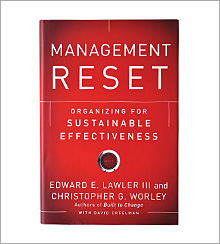Best Business Books 2011: Ethics and Aspirations
The Good Company Revisited
(originally published by Booz & Company)Howard Schultz with Joanne Gordon
Onward: How Starbucks Fought for Its Life without Losing Its Soul
(Rodale, 2011)
Edward E. Lawler III and Christopher G. Worley, with David Creelman
Management Reset: Organizing for Sustainable Effectiveness
(Jossey-Bass, 2011)
Michael Beer, Russell A. Eisenstat, Nathaniel Foote, Tobias Fredberg, and Flemming Norrgren
Higher Ambition: How Great Leaders Create Economic and Social Value
(Harvard Business Review Press, 2011)
Not since the 1980s has so much been written about the social role of business enterprises. An Internet search of such key terms as business purpose, values, ethics, responsibility, and sustainability yields page after page of references to recent articles in business journals, of both the popular and scholarly persuasions. This renaissance of interest in the topic is also reflected in a bumper crop of books published during the last year, the quality of which runs the gamut from the sublimely inspiring to the patently ridiculous.
A Perfect Brew
The pick of the 2011 harvest is Howard Schultz’s Onward: How Starbucks Fought for Its Life without Losing Its Soul, the renowned coffee purveyor’s tale of how he resuscitated the global chain after it nearly expired during the recent recession. Most business readers will be familiar with the story: Over 37 short years, Seattle’s little coffee shop expands around the world, growing to some 17,000 outlets, seemingly two on every block in major cities. During this time, Starbucks can apparently do no wrong. The chain becomes so successful that its founder and CEO, Howard Schultz, feels comfortable enough to kick himself upstairs to the chairman’s office and turn the company’s operating reins over to his chosen successor.
All seems right in Schultz’s world until 2007, when suddenly everything goes wrong. Just as the global financial crisis looms, Starbucks hits the wall, suffering from over-expansion and a widely perceived decline in the quality of its products. Customers disappear, the stock price drops from US$26 to $7 a share, and about $21 billion in market value evaporates in 10 months. With Wall Street bears predicting the company will go belly-up (one rumor has McDonald’s acquiring it in a fire sale), Schultz does exactly what the experts counsel against: He un-retires as CEO and moves back into the corner office.
On one level, Onward is Schultz’s explanation of why he chose to return to his old post and a chronicle of what he did to get Starbucks back on track. He reports in considerable detail the pain of terminating some 6,700 jobs, closing 800 stores, and bidding adieu to the CEO he had recruited to succeed him. He then describes the managerial steps he initiated to restore the company to its former, profitable self. But that turns out to be the least interesting part of the book, particularly for those familiar with the efforts of other CEOs who have had even greater managerial obstacles to conquer, such as the transformational challenge Louis Gerstner faced at IBM, which was, comparatively speaking, a colossal wreck when he assumed command in Armonk in 1993. Doubtless, Schultz’s task felt overwhelming to him, and he deserves much credit for leading a fast and full business turnaround, but that’s not the main reason to read his book.
What is special about Onward is that Schultz comes across as an authentic avatar of socially responsible capitalism. He seems to be a business leader of great conscience who tries always to do the right thing, practice what he believes in, and stick to his high principles in bad times as well as good. He is also that most unusual of celebrity CEOs — one who admits his mistakes, says he is sorry, and takes personal responsibility when things go awry. Schultz is far from perfect: He acknowledges making egregious product decisions against the advice of his management team, and although he tries hard to show humility, delegate authority, and be patient with subordinates, it’s clear he doesn’t always succeed in these endeavors. Nonetheless, he’s about as humble as American top executives get.
Of course, the measure of corporate leaders is not what they say, not how nice they are, not even the extent to which they have their egos under control. What matters is how they act, and by that metric Schultz shines. Consider a few things he did in the midst of his company’s financial crisis — and while stockholders, Wall Street analysts, and business journalists were carping about his every move. He started by being honest with everyone about what the company’s problem really was: Starbucks had lost sight of its values and, thus, was shortchanging its customers. In the past, the company’s goal had been to make “the perfect cup of coffee” for every customer, but Schultz acknowledged that its focus had shifted to generating growth at all costs to satisfy “the Street.”
To show he was serious about restoring the quality of Starbucks coffee, Schultz shut down all the company’s 7,100 North American stores for a barista video training session one Tuesday afternoon in February 2008. And to ensure that “the romance of coffee” would once again be central to the company’s culture, he brought Starbucks’s 11,000 store managers to New Orleans (at a cost of $35.5 million) for a week of discussions about the firm’s values, problems, and potential. Because one of those prime values was balancing profitability with a social conscience, the managers spent a day in the city’s Hurricane Katrina–devastated neighborhoods, where they donated 50,000 hours of community service. And, even as Starbucks’s team worked to cut costs and boost profits, the company redoubled its efforts with regard to the ethical sourcing of coffee beans and its complementary microfinancing and community development programs in impoverished rural areas.
That’s all impressive stuff, but to my mind, Schultz’s actions have been most admirable in the arena of employee relations. Schultz, we recall, grew up in Brooklyn’s housing projects, the son of a blue-collar worker who never made more than $20,000 a year. As a direct witness to the psychological injuries that too often result from low-level employment — as well as the physical injuries and the absence of health insurance and workers’ compensation to pay for them — Schultz vowed he would become the “good employer” his father never had. From Day One, Starbucks has offered the highest pay and most generous benefits (for part-timers, too) in the fast-food industry. Even when the company was hemorrhaging red ink, Schultz announced that Starbucks’s employee stock ownership and health insurance programs were sacrosanct.
Now that the company stock is trading near its all-time high, Schultz continues to engage in some rather unusual CEO behavior: He keeps reminding his 200,000 employees about the lessons Starbucks learned from its near-death experience. He says they must never forget that complacency and hubris are dangerous by-products of success; success must be re-earned every day by exceeding customer expectations; it is necessary to stay, and think, small even in a big corporation; growth needs to be disciplined and not subject to irrational exuberance; having passionate people is more important than having a robust strategy, ergo, treating employees with respect must be the company’s first order of business; and, although strategy, products, and policies need to be continually reexamined, Starbucks’s commitment to its basic values must be constant. Nothing original there, perhaps, but unusual in that Schultz’s actions seem to match his words. That’s called integrity, and Schultz sees that ethical virtue as a wellspring of the trust that motivates employees to make that little extra effort to prepare the perfect cup of coffee.
Although he doesn’t explicitly say so, Schultz’s ongoing leadership actions seem focused on institutionalizing Starbucks’s culture, so it will live on long after he vacates the C-suite. Schultz has good reason to be concerned: Not only were Starbucks’s values quickly diluted after he stepped down as CEO, but history shows that few companies are able to sustain highly responsible cultures after their founders step down. In the 1980s, I undertook a study of some two dozen firms widely recognized for their social commitments and ethical practices. Today, only a half dozen of the companies — Johnson & Johnson (J&J), Dayton-Hudson (now Target), Cummins, Xerox, W.L. Gore, and Herman Miller — are still in existence, still financially successful, and still practicing something like their original virtuous behaviors. Of those companies, J&J and Herman Miller had their commitment to virtue severely tested over the years, and Cummins and Xerox saw that commitment considerably weakened by new CEOs. More recently, three of yesterday’s exemplars of corporate virtue — Toyota, BP, and Goldman Sachs — have had their once-sterling reputations badly tarnished, and two of the most radically progressive models of social responsibility — Ben & Jerry’s and the Body Shop — lost much of their uniqueness when they were acquired by companies with more conventional business philosophies. Hard as it is to do good, it seems harder still to sustain that behavior.
Nuts and Bolts
The practical challenge of making good business practices endure is usefully addressed by Edward E. Lawler III and Christopher G. Worley in Management Reset: Organizing for Sustainable Effectiveness. Unlike most “eco-groovy” books published this year, Reset is research based, is realistic, and deals with the nuts and bolts of organizational management. And unlike other sustainability texts, this one doesn’t argue why companies should be economically, socially, and environmentally responsible; instead, it deals with how a company should be managed to achieve those ends. In effect, the authors’ starting point is where Schultz leaves off: They are seeking to overcome the tendency of good companies to fail because they are not as strategically and organizationally agile as they are socially responsible.
The authors group evidence for the sustainable management practices they advocate into four core business components: the way value is created (the formulation of strategy and competitive advantage), the way work is organized (the design of structure and systems), the way people are treated (how employees are recruited, developed, and rewarded), and the way behavior is guided (the role of leadership and corporate culture). They then disaggregate those categories by examining what social scientists have discovered about such practical tasks as strategy creation, board governance, organizational design, and management systems and rewards.
I am no fan of how-to books, but this one overcomes the main weaknesses of the genre by offering a balance of rigorous intellectual theory along with concrete examples (from companies including Procter & Gamble, W.L. Gore, Patagonia, Southwest, UPS, and DaVita) to illustrate the practicality of the authors’ ideas. Nonetheless, there is much to be said about this subject that Lawler and Worley (incidentally, my former university faculty colleagues) omit or overlook, and more than a few points they make are debatable. For instance, to my mind, they define high-involvement management so narrowly that they miss the potential contribution employees can make to the ends they advocate, and they ignore the value of employee stock ownership in creating company sustainability. So although Management Reset should not be seen as the final word on this important subject, it is an essential starting point for further thought, research, experimentation, and discussion.
The Leader’s Role
Curiously, there no longer seems to be much discussion about whether or not business should play a social, as well as an economic, role. Indeed, leaders of major global companies today feel compelled to at least lay claim to a “socially conscious” mantle. That’s probably why esteemed Harvard Business School professor Michael Beer (along with no fewer than four coauthors) skips the “why” foreplay and jumps directly into descriptions of the leadership practices of 36 current and past CEOs in Higher Ambition: How Great Leaders Create Economic and Social Value.
The authors offer breezy reports of their interviews with this “sample” of executives from a mixed bag of companies, including a few widely recognized for their social contributions (Tata, Cummins, Herman Miller); many better known for their managerial excellence than their social practices (Southwest, Medtronic, Asda); and one or two, like Nestlé, with records of questionable social performance. The book is significant, I suggest, because it accurately reflects the way that many leaders of large multinationals demonstrate their social consciousness: They assert it. Neither the executives interviewed nor Beer and his colleagues make direct reference to specific social programs, practices, or policies at their 36 exemplar companies (with the notable exception of Tata’s well-documented attempts to alleviate poverty in India). (See “Too Good to Fail,” by Ann Graham, s+b, Spring 2010.) Instead, what they document is that leaders of these companies create great places to work and engage in most of the familiar progressive management practices described in detail elsewhere by the likes of Tom Peters, Jim Collins, and Beer himself.
The authors take the 36 leaders at their word when they say they engage diligently in developing the leadership capacities of their organizations, use values as the glue in their corporate cultures, hold subordinates accountable for their actions, focus on execution and implementation, spend inordinate amounts of time in two-way communication with associates, and exercise team leadership. The executives also claim to listen to their associates, show them respect, and involve them in managerial decisions. And readers are assured that these leaders share the admirable character traits of humility and ethical integrity, all while being “uncompromising” (differentiating them, of course, from “rigid and inflexible” executives). Most important, the leaders confess to having well-developed stakeholder orientations and deep dedication to some higher social purpose that serves to motivate their troops and generate institutional loyalty (creating, in the words of Nokia’s Jorma Ollila, “a feeling that, gee, we can do something really good”).
I doubt none of this, and would have been surprised only had the authors found otherwise. Indeed, it is useful to reinforce the importance of such familiar practices because, as Beer and his colleagues aptly note, these are devilishly hard behaviors to engage in consistently. Yet the book misses golden opportunities to offer meaningful analysis of what these leaders actually do to create social value, and to provide an objective evaluation of the extent to which they actually add that value.
Since most of these leaders, in fact, have truly impressive records, we could have learned a lot from a critical analysis and assessment of their behaviors. For example, one of them, Allan Leighton, has been widely acclaimed for his brilliant transformation of Britain’s Asda in the 1990s, and tried to accomplish the same as head of the U.K.’s Royal Mail. Hence, the curious reader might want to learn the extent to which his successful practices at the discount retailer worked at the nonprofit postal service, and how creating social value fit with his tasks at the post. Alas, we are told none of that and, instead, are treated to recitations of the leaders’ management-speak aphorisms: “Keep it simple,” “Commit, yet adapt,” “Stay the course.” All good advice, but as Yogi Berra said, it’s déjà vu all over again, and it’s unclear how it all relates to creating social value.
It must be said that Higher Ambition makes a deeper analytical contribution than most other recent books purporting to show that corporations can do well by doing good. The message of most others of that genre boils down to a hyperventilated exhortation to “save the world while getting rich!” Higher Ambition’s authors at least make an attempt to distill the wisdom gleaned from their interviews, basically concluding that good companies share such general characteristics as a stakeholder orientation, a dedication to some higher purpose, a commitment to continuous learning that leads to flexibility, and the pursuit of excellence across the board.
It is worth noting that these are roughly the same characteristics of the good companies that I studied in the 1980s — and significantly, only two of those make the grade on Higher Ambition’s contemporary roster. How to explain that manifest lack of sustainability in corporate virtue? From reading Higher Ambition, my guess is that organizational traits may not be the most relevant factor in determining why or how some profitable companies do good things while others don’t (instead, such traits may be a result of doing good, what social scientists call dependent variables). Instead, I am now inclined to believe that having a dedicated, courageous leader is the key factor in determining the extent to which a company has a social conscience. And, since leaders come and go, the questions to address then become: (1) what motivates executives to create ethical, socially responsible corporate cultures; and (2) how can such behavior be encouraged among greater numbers of leaders? Beer and his colleagues eventually come around to addressing those questions in their penultimate chapter, but they don’t really develop the answers, which remain rather sketchy. Seems a shame that they didn’t focus their book on those ripe subjects.
Missing, in general, from most books in the still-emerging “good business” genre is a recognition of such harsh facts of business life as the managerial necessity to make painful trade-offs between competing claims of stakeholders, for example, those of environmentalists on one side and employees on the other. Too many sustainability authors deal with such complex, unpleasant issues simply by ignoring them, but, fortunately, they don’t all have their heads in the clouds. There’s no eco gee-whiz and no promises of a utopia in which capitalists all get rich simply by being virtuous in any of the best books on ethics and aspirations this year. I found them to be the most inspiring of the current lot because they demonstrate that there are practical, better ways to manage, even given the real-world constraints of capitalism as it is and the tough, daily slog that is the salient fact of organizational life.![]()
Author profile:
- James O’Toole is the Daniels Distinguished Professor of Business Ethics at the University of Denver’s Daniels College of Business and coauthor, with Warren Bennis and Daniel Goleman, of Transparency: How Leaders Create a Culture of Candor (Jossey-Bass, 2008).




